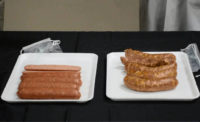AAMP Convention: 2016 American Cured Meat Championships
[Video] How to judge semi-dry sausage, specialty cured products
Dr. Ryan Cox discusses judging the semi-dry sausage (non-fermented) category and the specialty cured products
Independent Processor editor-in-chief Sam Gazdziak spoke with Dr. Ryan Cox of the University of Minnesota about judging the semi-dry sausage (non-fermented) category and the specialty cured products.
Sam Gazdziak: I’m here with Dr. Ryan Cox of the University of Minnesota. Ryan, you are one of the judges for the American Cured Meats Competition. What categories did you have this year?
Dr. Ryan Cox: This year, I judged first the semi-dry sausage, non-fermented category, a slightly smaller category with 17 entries this year. It’s largely summer sausages. There is another category where the product is fermented, but this is the non-fermented category. Then I also did the specialty cured products, a larger category with whole-muscle and sausage products in it.
Gazdziak: For some of the products that you have here, in general, what are the characteristics that you are looking for in a good award-winning entry?
Cox: For this particular category, for example, we start with external appearance. We are looking for a good color. Generally a lack of defects, manufacturing defects, things that would take away from the appeal or eye appeal of the product. With this product here, the external texture is the external texture here. There is a difference where wrinkling is concerned. You’ll also notice there is a difference in color. We want a more brilliant color, a deeper color, as opposed to a flatter color or pale or washed out color. Then, we turn to the internal. We create a cut and look at the internal of the product. Looking for particle definition as well as cured color, and then again a lack of defects. So there’s a lot of things we consider in looking at these products, and this is well before we even taste the product. The flavors of the products, textures, the mouth feel are actually carrying the majority of the points in all of these categories.
Gazdziak: So Ryan, we have a couple of examples here from the semi-dry non-fermented sausage category, could you talk a bit about what are some of the things you are looking for in the judging?
Cox: We start judging by looking at the external surface of the product, evaluating the workmanship of the product. So looking at the outside. Obviously looking at the color whether it picks up a more brilliant, deeper, richer color like the one here versus a slightly flatter color, a little bit more pale, which you can see here. Again texture, the workmanship. When you think of the texture of this product here being obviously more wrinkly or dried versus this being a smoother texture as well. That’s how we evaluate it at first. Then we go to the internal surface. As you go to the cut surface, you can see the particles. We look for particle definition. The fat to lean particle definition. The color of the product, which has been cured, and so it should have a more brilliant cured color as we would see in this product here versus a flatter color here that you would see. Again, looking at a lack of manufacturing defects. Things like air holes, excessive connection tissue, things of that nature. That’s how we start judging. This is again before we taste the product. The majority of the points are in the flavor of the product and the mouth feel, which is the eating experience. So there’s quite a bit that’s considered when we evaluate these products.
Looking for a reprint of this article?
From high-res PDFs to custom plaques, order your copy today!





